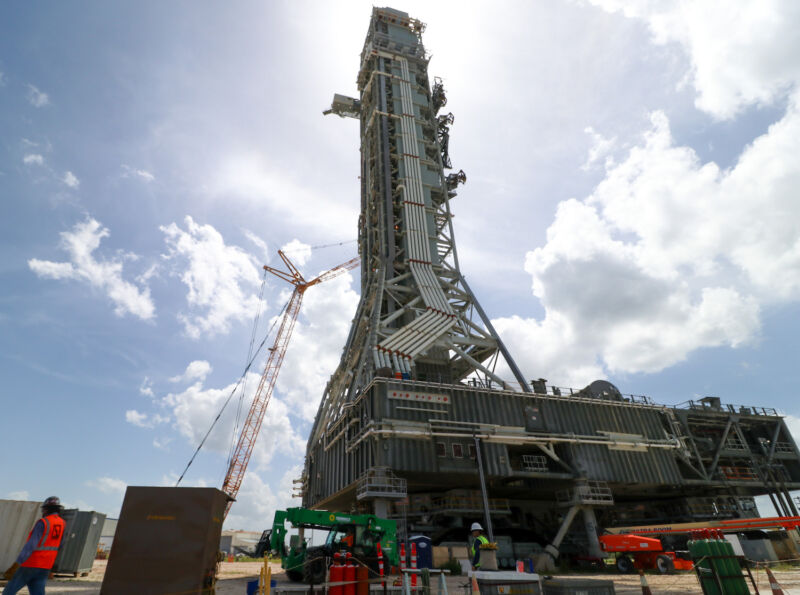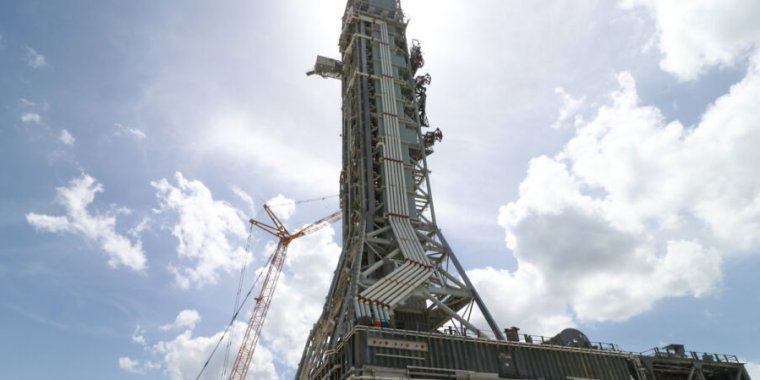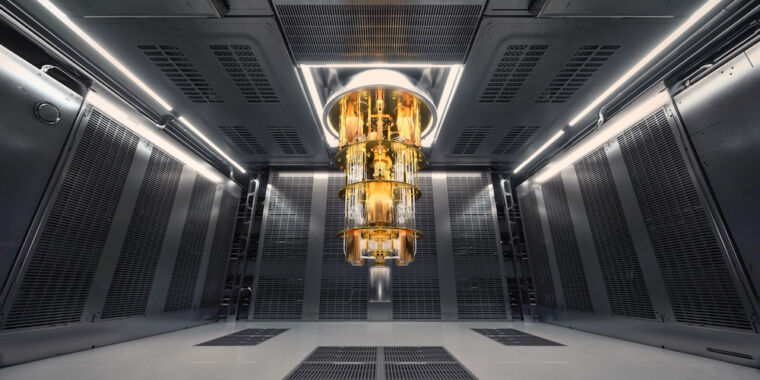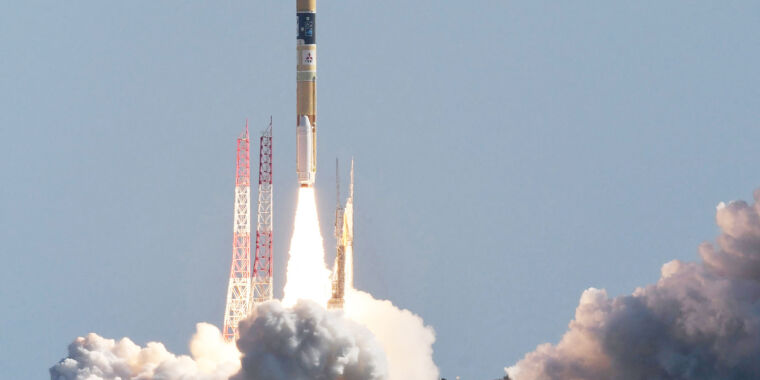
Stephen Clark/Ars Technica
NASA’s repaired and upgraded mobile launch platform moved back to its launch pad at the Kennedy Space Center this week. This marks a transition from refurbishment after the launch of the Artemis I mission last year into preparations for Artemis II—the Moon program’s first flight with astronauts.
The giant structure sustained more damage than expected during the first launch of NASA’s Space Launch System rocket last November. The 380-foot-tall (116-meter) launch tower has been parked just north of the iconic Vehicle Assembly Building since January, undergoing repairs and modifications to prepare it for its next use on Artemis II.
That work is now largely complete, and NASA’s Apollo-era crawler-transporter began moving the launch platform back to Launch Complex 39B on Wednesday for about four months of testing. Then, if all goes well, NASA will declare the structure ready for stacking of the SLS Moon rocket for Artemis II.
“What’s the mood? I think folks are really ready to get back into pad operations,” said Jeremy Parsons, deputy manager of NASA’s exploration ground systems program at Kennedy. “They’re really ready to get back into stacking. It’s been a push, but I can’t be more proud of them.”
NASA is using the $1 billion launch platform for its first three Artemis missions. This is the structure that the rocket sits on during launch preparations, moving the vehicle between its assembly building and its seaside launch pad at Kennedy. Assembly of a separate, larger, more expensive tower is finally underway at the Kennedy Space Center for missions starting with Artemis IV in the late 2020s.
After launching from Florida on the SLS rocket, the Artemis II mission will carry four astronauts on a loop around the far side of the Moon. The crew members will ride inside NASA’s Orion spacecraft for the roughly 10-day flight, the first time people will have traveled to the vicinity of the Moon since 1972.
The Artemis II test flight will set the stage for more ambitious flights to the Moon, with eventual human landings at the south pole and construction of a mini-space station called Gateway in lunar orbit.
Looking ahead to Artemis II
We’ll discuss the details of the mobile launcher upgrades later in this story, but first, let’s preview how NASA hopes the Artemis II launch campaign will proceed next year.
Jim Free, who oversees NASA’s Artemis Moon program, said last week that preparations for the Artemis II mission are a few weeks behind schedule from the agency’s target launch date in November 2024. That’s no big surprise, and Ars has reported a slip into 2025 is likely.
But NASA hasn’t officially given up on November 2024. Parsons told Ars this week that the ground processing team in Florida is looking for efficiencies in the Artemis II launch campaign to counter delays in the Orion spacecraft, the readiness of which is now driving the launch schedule. This Orion capsule will debut new life-support systems, cockpit displays, and controls that didn’t fly on the unpiloted Artemis I mission last year.
In broad strokes, here’s a look at the timeline over the next year or so.
- August: Mobile launcher rolls to Launch Complex 39B for testing
- September: Pre-fueled solid rocket booster segments arrive at Kennedy Space Center by rail from Northrop Grumman’s Utah assembly site; Orion crew and service modules are mated at Kennedy to begin integrated tests
- November: SLS core stage ships to Kennedy from the Michoud Assembly Facility in Louisiana
- December/January: Mobile launcher returns to Vehicle Assembly Building to prepare for stacking
- February: Stacking of the solid rocket boosters begins on the mobile launcher
- April: Core stage is stacked in between the solid rocket boosters; Orion spacecraft is handed over to ground processing team for fueling
- May: Interim cryogenic propulsion stage is stacked on top of the core stage
- Mid-2024: Orion spacecraft is fueled and launch abort system is installed before moving to the Vehicle Assembly Building for stacking








